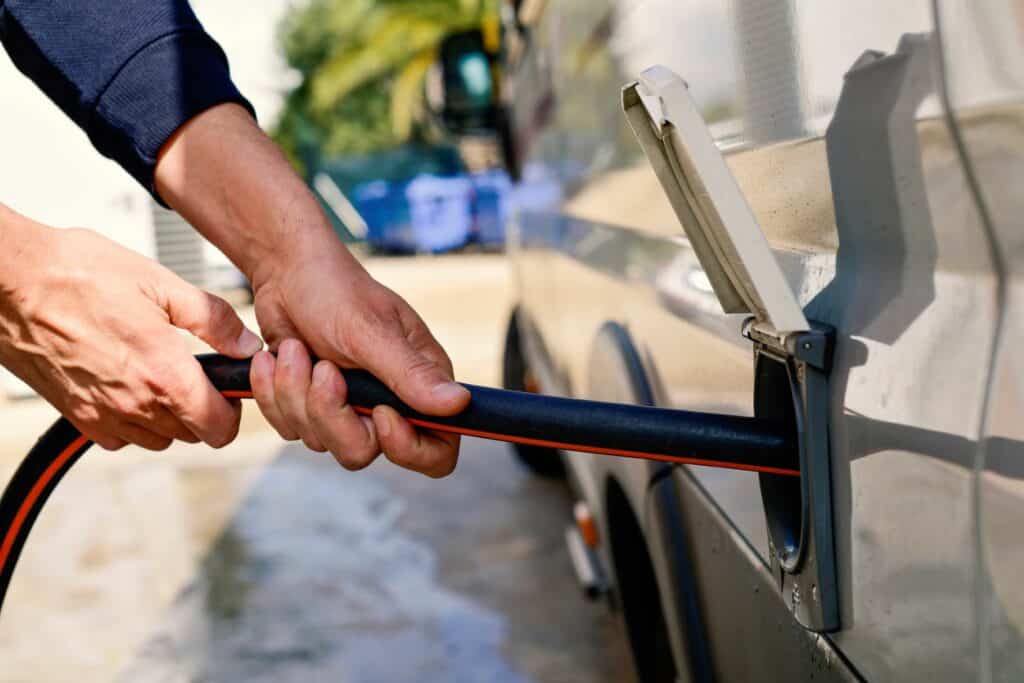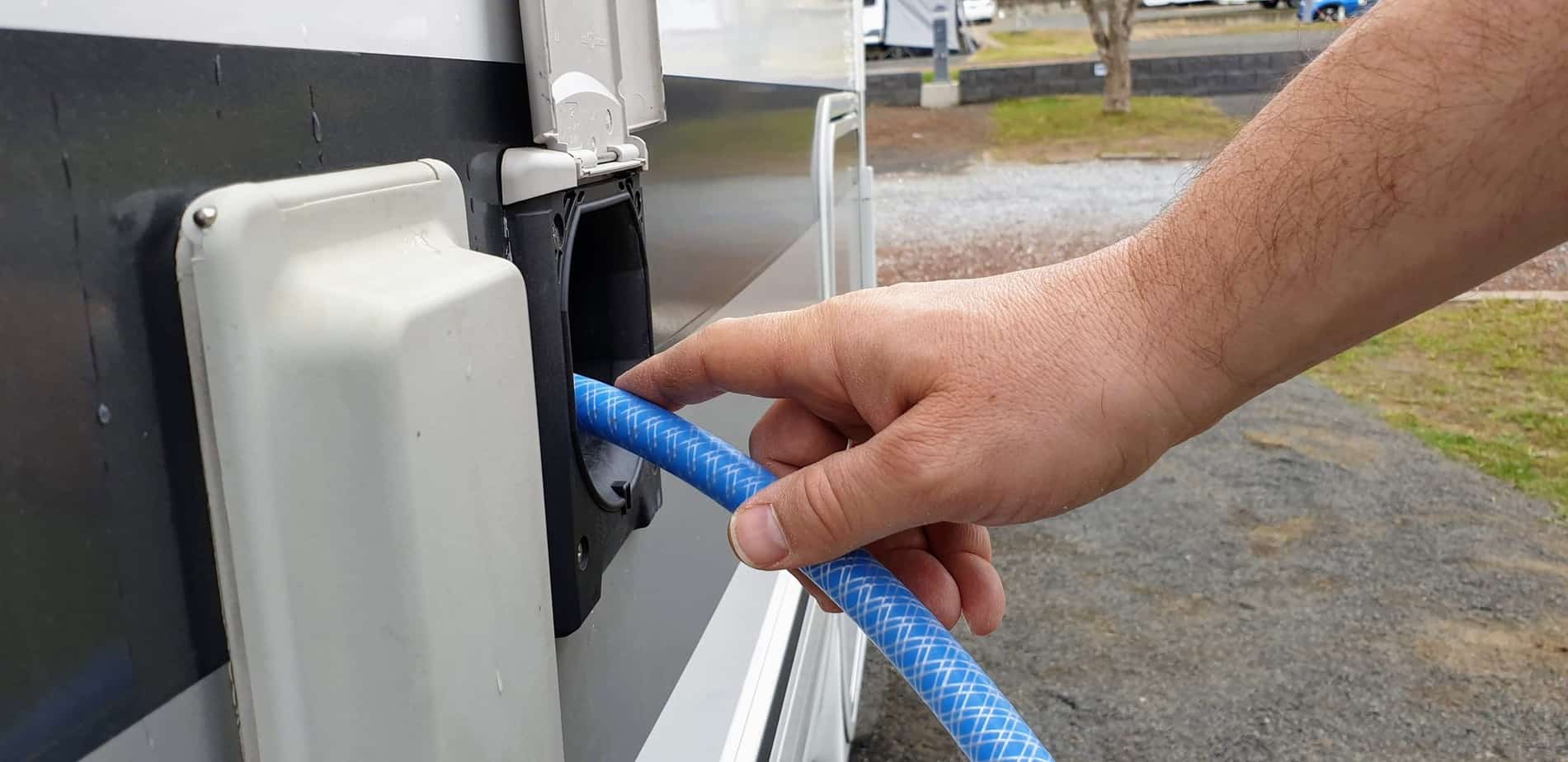When unused, water can generally stay fresh in an RV tank for around two weeks. This will depend on weather conditions, the cleanliness of your water tank, and the source of the water. If leftover long periods, the water may become unpalatable, undrinkable, and potentially unsafe.
There is no exact limit on keeping fresh water in RV tank conditions before it becomes unusable, but contaminated drinking water can be hazardous. Our article outlines common practices and key guidelines for understanding how to keep your RV tank water fresh and clean.
How long to keep fresh water in an RV tank?
Opinion varies between sources and RV owners on the exact lengths of time freshwater should be kept in an RV tank. As a general guide, two weeks is commonly used as a cut-off point beyond which many would not keep water in their tanks.
After two weeks, you should completely drain and refill your tank. You can drain out any remaining water by, e.g., running the shower until it’s gone.
In hot weather, water can become stagnant more quickly, and in cold weather, it may remain fresh for longer. Water from untreated non-municipal sources (e.g., wells, rivers) won’t remain fresh as long as municipal water supplies that may have been treated (e.g., with chlorine) kill microorganisms.
If you are unsure about the freshness of the water in your RV tank, then empty and refill it, or use it only for flushing toilets, watering plants, etc.
What is an RV fresh water tank?
An RV fresh water tank is the store used to carry water for drinking, washing, and general use in your RV. Normally built into the frame structure underneath the RV, freshwater tanks are made from reinforced fiberglass or heavy-duty plastic.
When turning on an RV tap or faucet or flushing a toilet, a pump draws water from the RV fresh water tank and sends it out through a pressure release valve.
The freshwater tank is one of three completely separate RV water tanks. Water from the sink or shower drains is diverted into a ‘gray water’ tank, and wastewater from flushing the toilet is stored in a “black water” tank.
With an RV fresh water tank, you are not tied to campsites and parks with water hookups. If you enjoy boondocking or camping off-grid for extended periods, a capacious freshwater tank can help you.
RV fresh water tanks come in different capacities, with 8 gallons and 16 gallons being common sizes.
What happens if the water in my RV tank gets too old?
Several things can happen to water left sitting too long in a tank.
Firstly, the water may begin to take on an unpleasant plastic smell or taste from stagnating inside a plastic tank.
More dangerously, bacteria, mold, and algae can live and grow in sitting water. Some of these microorganisms could cause health issues in significant quantities. Legionella, salmonella, and E. coli might all thrive in a stagnant RV water tank. Old water should therefore not be used to drink, cook or shower.

How do I keep my RV’s fresh water tank fresh?
Several regular practices and actions can help keep the water in your tank fresher for longer.
Use your water: Using and refilling your tank regularly will prevent water from stagnating. It is when water is still for long periods that microorganisms can breed.
Sanitize your system: The freshwater tank in your RV should be sanitized regularly following the steps outlined below. Every six months or as needed is a common rule of thumb. This may also be good timing to remind you to replace the RV water filters.
Avoid contamination: Keep your freshwater hose clean, sanitized, and stored separately from items that could contaminate it (e.g., a sewer hose, or gardening equipment). You can connect the ends of the hose to keep it safely sealed up when not in use. The hose can be sanitized by soaking in dilute bleach water for 10 minutes before rinsing with cold water.
Inline water filters: Using an inline water filter can also help keep fresh water in your tank for longer. A simple and inexpensive attachment to your freshwater hose, an inline filter unit deep cleans water as it enters your RV, removing bacteria and sediment.
How do I sanitize my RV freshwater tank?
There are several steps in the process of sanitizing an RV fresh water tank.
- Begin by turning off any water heating system and draining the tank until it’s empty. It’s essential to turn off the heating to avoid damage to the water heater.
- Work out the correct amount of bleach you will need on a ratio of roughly 1/4 of a cup of bleach per 16 gallons of water (or 1 oz per 8 gallons). For example, for a 20-gallon RV tank, you will need 2.5 ounces of bleach to sanitize the system.
- Dilute the bleach in at least a gallon of water before adding this mixture to your freshwater tank using a funnel.
- Fill the tank with potable (drinkable) water and pump this water fully through the system to ensure every area is sanitized. Turn on all faucets/taps to bring the bleach water through every pipe and fitting. They can then be turned off again.
- Allow the bleach solution to sit in the tank for 8-12 hours, perhaps overnight. This time will ensure that the bleach has the chance to kill as many germs as possible.
- After 12 hours, you can drain the bleach solution from the water tank. Refill with fresh water and pump through the water system, opening all faucets/taps again. Flush water through the system until there is no longer any bleach smell detectable.
A final word…
Now you know the main facts about how long to keep fresh water in RV tank conditions.
Your RV water tank can be a beneficial asset when camping off-grid or boondocking for more extended periods. If you follow sensible guidelines and maintain your RV fresh water tank sensibly, you should have no problem accessing clean fresh water when you need it.
If you ever have concerns about the smell, taste, freshwater, or appearance of water in your RV fresh water tank, drink bottled water or water from other potable sources until you can drain down and refill your system sanitizing as needed.
Don’t forget to check out our Recommended RV Equipment list!
Get a FREE copy of the Go Together Go Far Travel Trailer Hookup and Disconnect Checklist when you sign up for the Go Together Go Far Newsletter!
Want to learn more about different types of RVs? Check out:
- Best Off-Road Camper Trailer Under $10,000
- Best Bunkhouse Travel Trailer Under 30 Feet
- Are Lance Travel Trailers Any Good?
- Do Rope Lights Deter Rodents?
- What Are the Best Names in the RV Industry?
- 3 Best Travel Trailers for Family of Four
- Blue Ox SwayPro Basics: Top Questions Answered
- Adding A Washer Dryer To Travel Trailer? What You Need To Know.
- Best Drone For Camping, Backpacking, and RVing: A Complete Guide to Drones for RVers
- Furniture and RVs – How To Get It Through the Door…
- How To Get Rid Of A Poop Pyramid In RV Black Tank
- Do You Know How Long To Keep Fresh Water In RV Tank Storage?
- What Is The Best Outdoor Security Camera System For Your RV?
- RV Bumper Mount Grills: 5 Best Options For Your RV Or Camper
- Best Electric Tankless Water Heater for Your RV. What You Need To Know
- Read Before You Buy! How to Find the Best Scooter for RV Camping
- 3 Best Travel Trailers for Family of Four
- Top RV Brands: What Are the Best Names in the RV Industry?
- Lance Campers: What Makes Them So Different?
- Best Bunkhouse Travel Trailer Under 30 Feet
- Best Off-Road Camper Trailer Under $10,000
- Best Weight Distribution Hitch With Sway Control For Travel Trailers in 2022
- What Are The Best Built Travel Trailers? Things To Consider.
- How Does An RV Refrigerator Work? A Quick Guide.
- Why Does My RV Carbon Monoxide Detector Keep Beeping? A Quick Guide.
- Where Is The Power Converter In My RV Or Travel Trailer
- What is the Best Generator for 50 Amp RV?
- Wireless RV Security Camera Systems: Is Solar Powered Security Without Wi-Fi An Option?
- Best Portable Air Conditioner for Camping for 2022
- How to Find the Best 3500 Watt Inverter Generator for RV Camping
- Best Propane Generator For Your RV: Read This Before You Buy!


